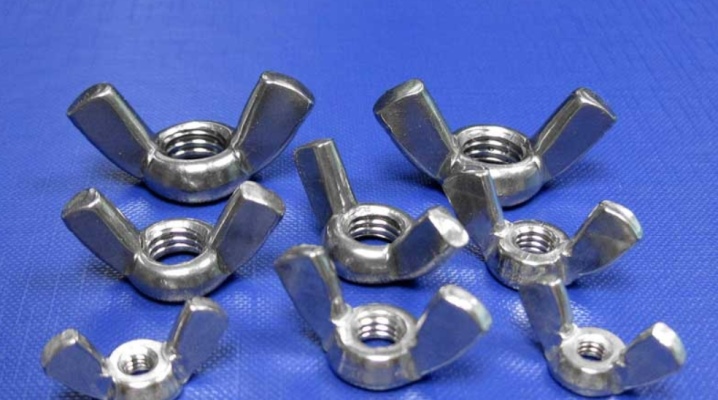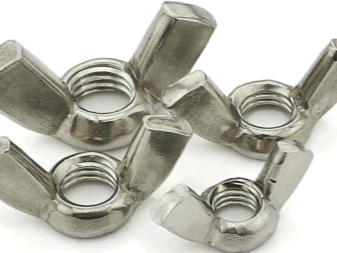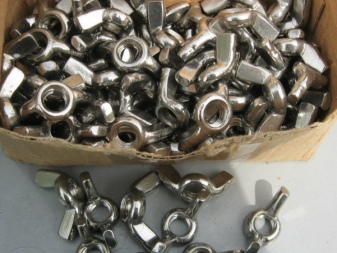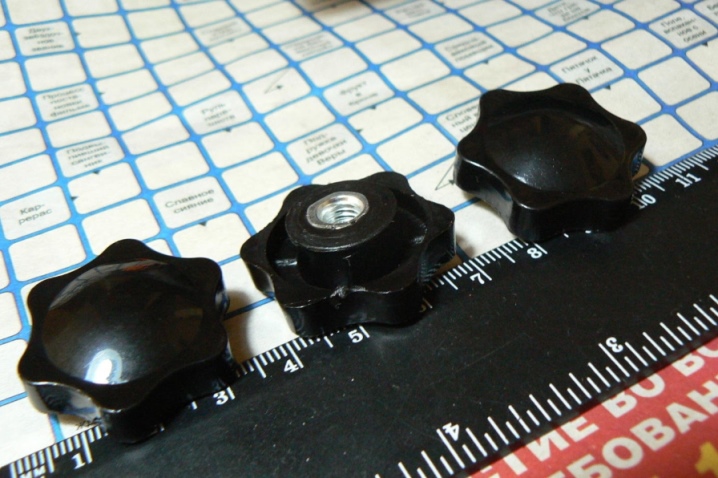All about wing nuts

A wing nut is a rather peculiar fastening element designed to mount something without additional devices and mechanisms, that is, with the help of only hands. This hardware received its name for the presence of "ears", which were seen to be similar to ram's horns. Rotating the lugs by hand allows you to tighten or, conversely, to loosen the fastening. The first wing nut was patented in Germany at the beginning of the 20th century, which is why fasteners with rounded lugs are called "German". Soon, a more technologically advanced modified version of the bent steel lamb was patented in the USA. Outwardly, it is easy to distinguish it by its square ears - this version was named "American".


Peculiarities
Both of these variants of wing nuts are now equally widespread. But the evolution of such manual fasteners did not stop there: new modifications appear, but now from different materials.
The main technical feature of the wing nut is its self-sufficiency. Of course, using it without a bolt or stud is impossible, but even these hardware are selected so as not to use a key or screwdriver to hold them. For example, a hairpin can be welded or have a loop instead of a head, with which it is movably attached to an object or part. The bolt should also not have a wrench head or screwdriver. For example, bolts used when installing wood products may have a rounded head and special stops that, when cutting into the wood, prevent rotation when tightening the fasteners.


The wing nut combines both fastening hardware and a tool for its installation. The need for such a fastener arises in cases where it is necessary to quickly tighten or loosen the thread of the fastener of a removable part, which is not a member of the supporting structures. Finding a wrench or screwdriver would take an unreasonable amount of time. At the same time, the effort of one hand is sufficient for functional fastening without additional devices.

Dimensions (edit)
As indicated by GOST 3032-76, wing nuts differ in material of manufacture and size. The main parameter on which all the others depend is the diameter of the threaded hole. It conforms to industry standard bolt and nut sizes and markings.
The minimum standard size is M3. This means that the diameter of the bolt thread onto which such a nut can be screwed is 3 mm. A number of subsequent sizes of wing nuts looks like this: M4, M5, M6, M8, M10, M12, M14, M16, M18, M20, M24.


It is quite expected that the outer dimensions of the nuts will increase in the same order. Most German-style wing nuts have holes in the lugs. The purpose of the holes is not only to lighten the hardware: some craftsmen use them to fix the hardware in a certain position with a wire. But more often a cable or nylon thread is tied to them in order to avoid the loss of hardware.
According to the thread pitch, wing nuts are divided into products with large and small threads, the pitch of which is determined by the size of the hardware. Only large threads have small lambs: M3, M4, M5, M6. Nuts M8 and beyond are available with both threads. This fact should be considered when buying fasteners. If there is no experience in determining the size of the thread, the stud or bolt on which the nut is supposed to be screwed can be taken with you as a sample.

Closed wing nuts, which have a restriction on the length of the studs on which they have to be screwed, are much less common on sale. The sizes of such hardware start from M6, no less. There are usually no thread pitch options - a standard coarse thread is cut on all of them.


Materials (edit)
Wing nuts are made from various materials. Metal fasteners are traditional.
Due to the small static and dynamic forces acting on the joints with such nuts during operation, carbon steels can be used for their manufacture. These alloys are relatively strong, their cost is low, but there is a drawback - they corrode. In addition, such products do not always satisfy aesthetic requirements. Often, oil-impregnated coatings are applied to them in an attempt to slow down corrosion damage. For this reason, galvanized steel products are more common, not only successfully resisting corrosive processes, but also having a rather presentable appearance. In addition to zinc, other non-ferrous metals can be used to cover steel wing nuts: copper, nickel, tin, silver and their alloys.
The most durable are stainless steel hardware, however, combining strength and aesthetics, they have a high cost. But since such removable fasteners are never used in large quantities, the use of stainless steel is quite justified.


The unique properties of organic polymers have led to their use for the manufacture of fasteners with special requirements, for example, with increased resistance to moisture. Modern fasteners for furnishing bathrooms do not require increased strength, but water resistance is required. Therefore, here you cannot do without plastic nuts, which do not require much effort during installation, tightening with one hand.
Widely used lambs made of hard plastic with a steel core. Various types of equipment and devices are fixed with these products. They are relevant where it is necessary to frequently unscrew and tighten fasteners, but at the same time the effort is limited by the dynamic properties of the materials.

Application
As already mentioned, wing nuts can be found wherever a lot of effort is not required, but often lightweight structures have to be mounted and dismantled.
So, steel products are used to install fuel filters on some engines. This structural element has to be changed quite often.
In addition, they can be seen on the lids of sealed thermos tanks. The covers have to be opened and closed several times a day, and it is unacceptable to damage the sealing gasket, which ensures tightness, by overtightening the nuts.
The use of such products for fixing hatch covers, sealed doors or windows is also based on this.
In some cases, closed-type fasteners are used. (when the ears of the nuts are connected in the form of a metal loop). Such hardware has a higher decorative component, therefore, it can be used to fix some household appliances.

Galvanized and stainless steel lambs can be seen in demountable timber structures. For example, sketchbooks or easels, which are attributes of artists, have a number of adjustable and folding parts. It is impossible to imagine them without shiny lamb nuts.
Wing nuts are widely used in photography tripods, stage lighting and sound amplifiers. Installing and adjusting such equipment is required very often, and it would be very inconvenient to carry keys and screwdrivers for this.


Large-sized manual adjusting nuts, developed from wing nuts, can be found in the design of modern office chairs.
Closed-type plastic wing nuts with steel cores are used for mounting some electrical measuring instruments and radio equipment. Here they make it possible to reliably isolate the fastening elements, preventing the possibility of short circuits.
How soft plastic fasteners are used when installing plumbing and other plumbing equipment has already been mentioned. But it should be clarified that any tool cannot be used with such material, since the force created when tightening by hand is quite enough in this case.



The next video shows you how to make a wing nut with your own hands.













The comment was sent successfully.